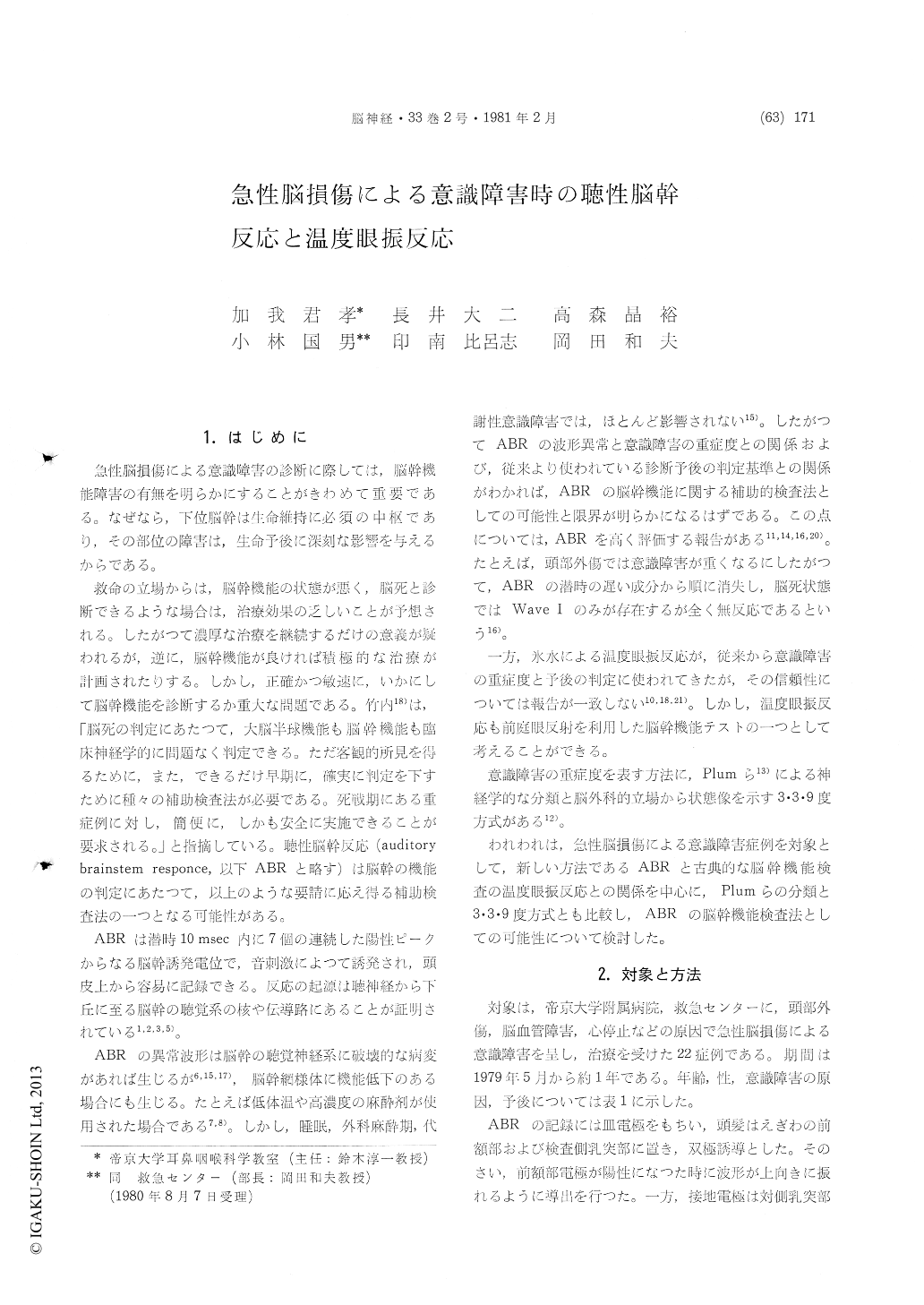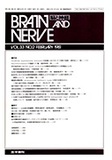Japanese
English
- 有料閲覧
- Abstract 文献概要
- 1ページ目 Look Inside
1.はじめに
急性脳損傷による意識障害の診断に際しては,脳幹機能障害の有無を明らかにすることがきわめて重要である。なぜなら,下位脳幹は生命維持に必須の中枢であり,その部位の障害は,生命予後に深刻な影響を与えるからである。
救命の立場からは,脳幹機能の状態が悪く,脳死と診断できるような場合は,治療効果の乏しいことが予想される。したがつて濃厚な治療を継続するだけの意義が疑われるが,逆に,脳幹機能が良ければ積極的な治療が計画されたりする。しかし,正確かつ敏速に,いかにして脳幹機能を診断するか重大な問題である。竹内18)は,「脳死の判定にあたつて,大脳半球機能も脳幹機能も臨床神経学的に問題なく判定できる。ただ客観的所見を得るために,また,できるだけ早期に,確実に判定を下すために種々の補助検査法が必要である。死戦期にある敵症例に対し,簡便に,しかも安全に実施できることが要求される。」と指摘している。聴性脳幹反応(auditorybrainstem responce,以下ABRと略す)は脳幹の機能の判定にあたつて,以上のような要請に応え得る補助検査法の一つとなる可能性がある。
Auditory brain stem responses (ABR) and cold caloric stimulation were evaluated as aides in the early diagnosis and prognosis of 22 comatose brain injuried patients.
2000 click stimuli (85 dB SL, 10/sec) of ABR were presented monoaurally through headphones and the configuration and peak latencies of ABR were measured.
The patients were classified into four groups: A) normal ABRs and fair prognosis (7 cases), B) normal ABRs and poor prognosis (6 cases), C) brainstem damage pattern of ABR and poor prognosis (3 cases), D) absence of ABR and poor prognosis (6 cases).
The results of cold caloric stimulation were devided into 6 stages according to the different states of consciousness.
I) Normal response ; II) Tonic lateral conjugate deviation of eyes toward the irrigated ear with decreased nystagmus ; III) Tonic lateral conjugate deviation of eyes toward the irrigated ear without nystagmus ; IV) Tonic lateral conjugate deviation of eyes ; and VI) No response at all (Fg. 1).
Each group of the patients showed different stage of cold caloric stimulation: Group A (one case of stage I, five cases of stage III and one case of stage IV). Group B (one case of stage IV and five cases of stage VI), Group C (two cases of stage IV and one case of stage VI) and Group D (all cases were in the stage VI).
In conclusion, ABR is a useful tool as well as cold caloric stimulation for detecting brain stem damage. The prognosis of patients will be poor ifABRs show brain stem lesion or no response but the fair prognosis will not be always expected even if ABRs are normal. On the other hand, ocular responses of cold caloric stimulation as a classical method seem to be more useful than ABRs for eval-uating the depth of coma and the prognosis. How-ever, ABRs will aid diagnostically in determing the extent of brainstem damage and the effective-ness of treatment.

Copyright © 1981, Igaku-Shoin Ltd. All rights reserved.


